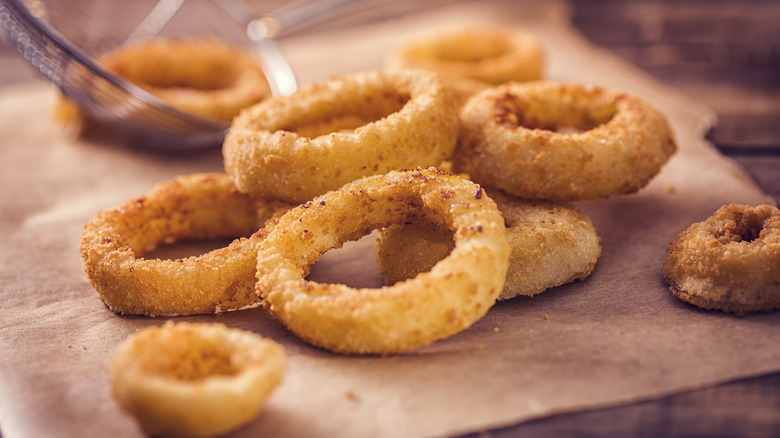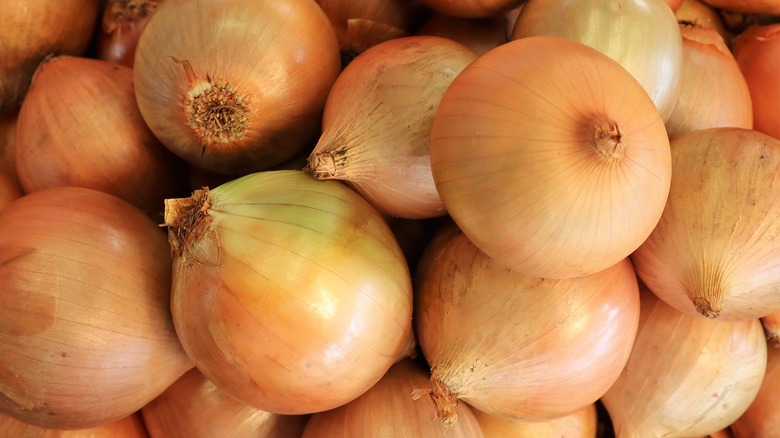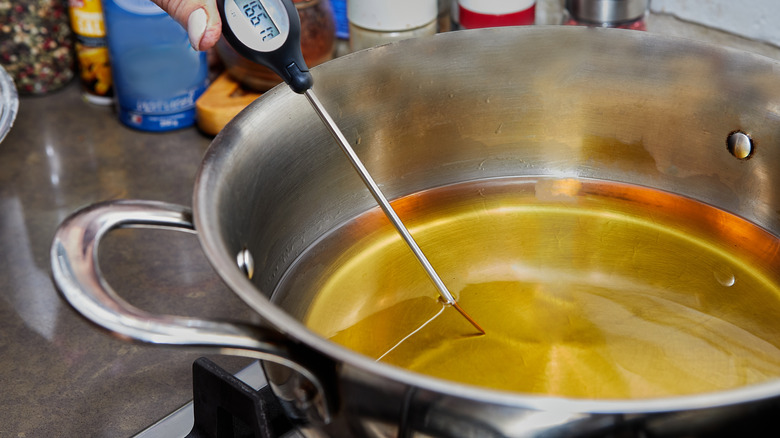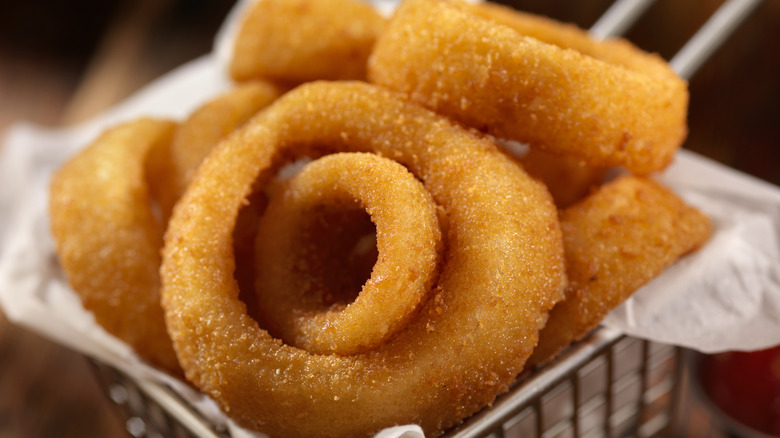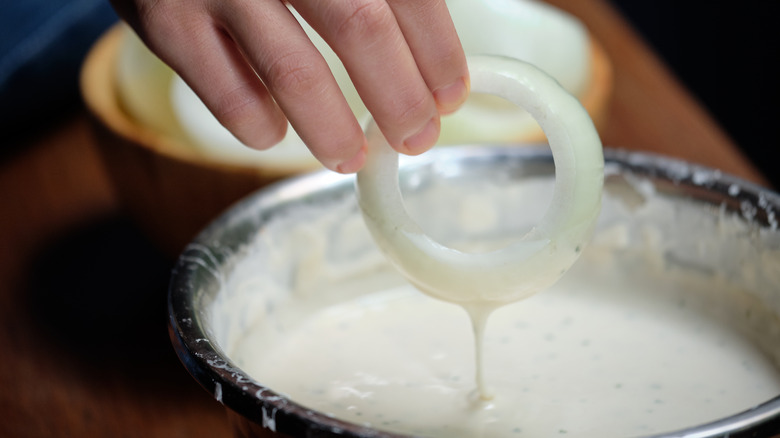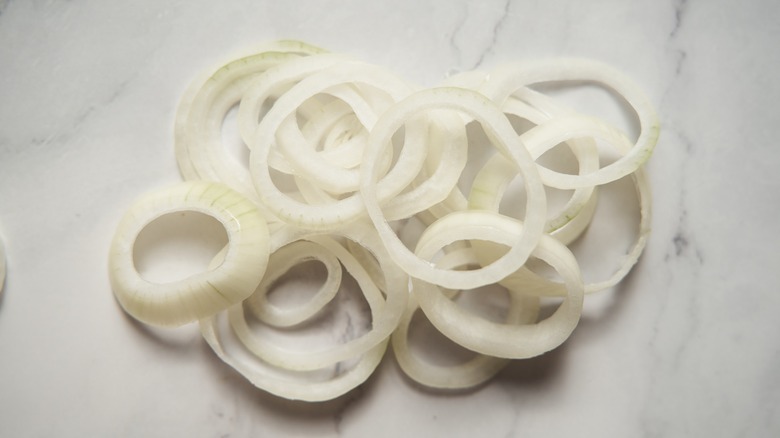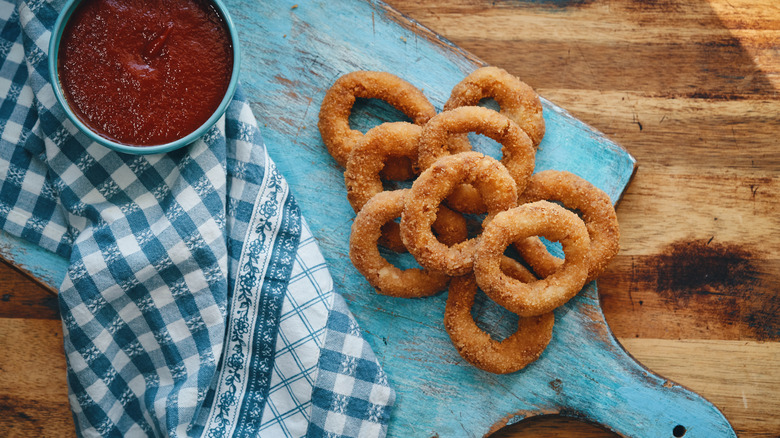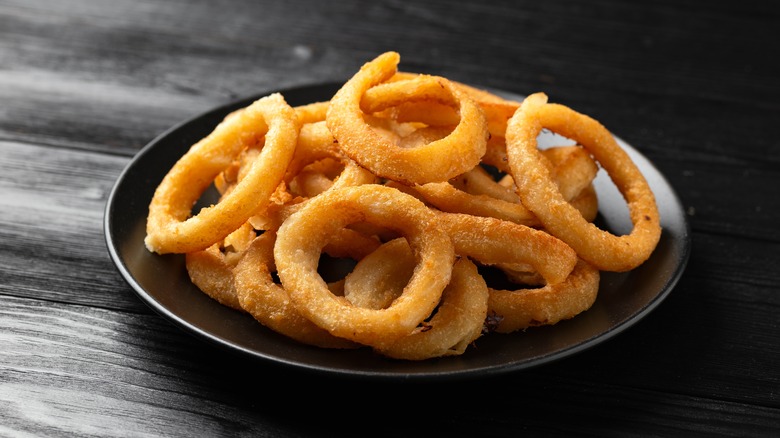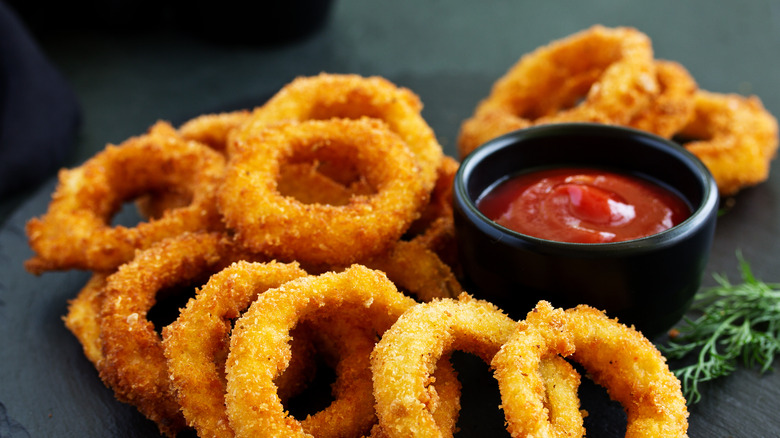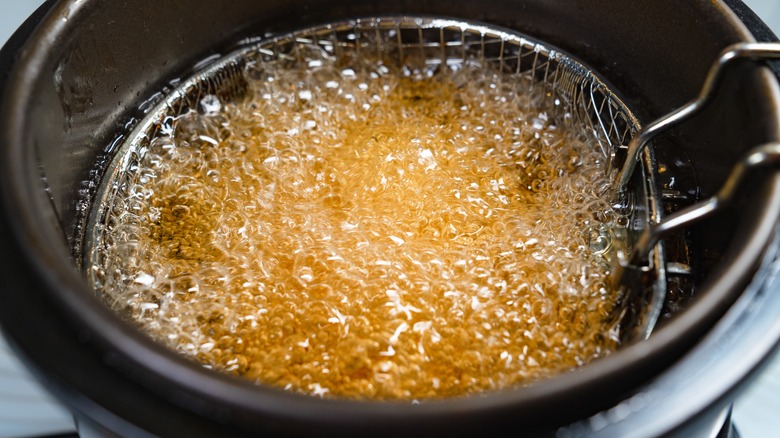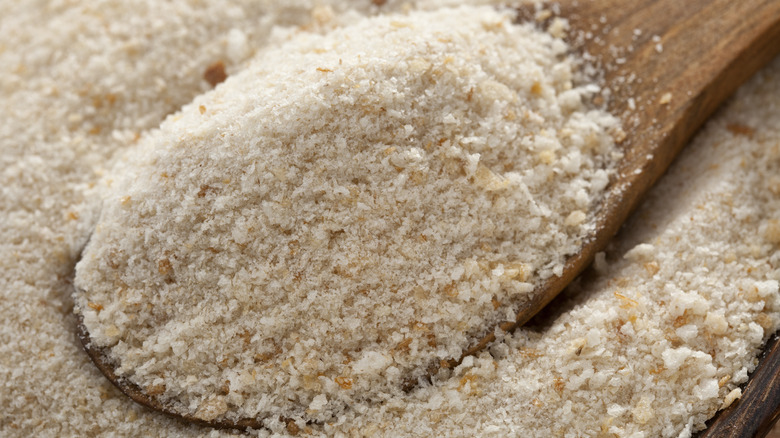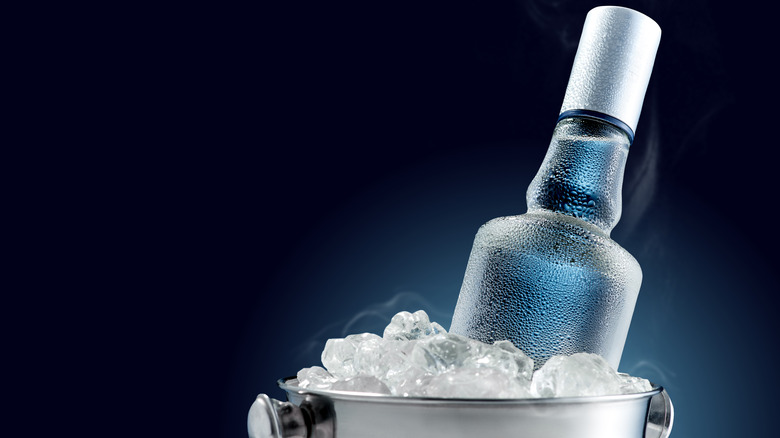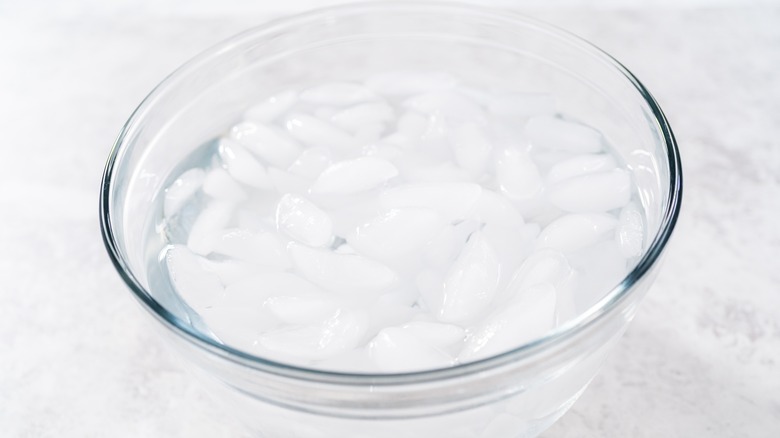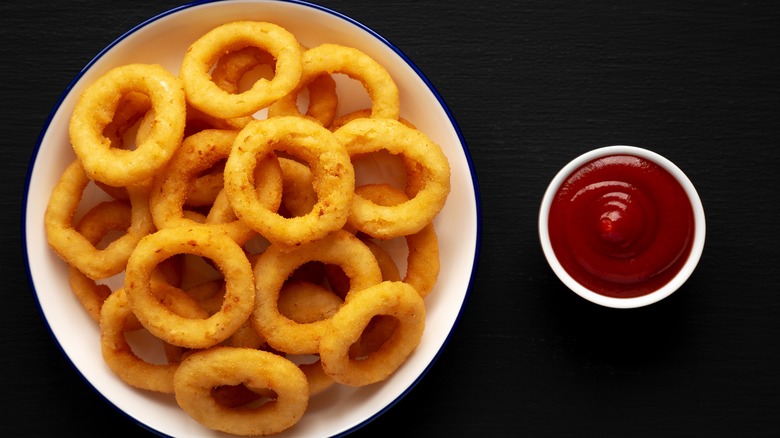Chef Says You're Probably Making These Mistakes When Cooking Onion Rings
For such a simple food, onion rings can be very easy to get wrong. The combination of sliced onions and a crunchy coating, made crispy and delicious by an immersion in hot oil, have been around for a while, with the origin story of onion rings extending back more than 100 years. Since their invention, though, people have been plagued with soggy, mushy, tasteless, and undercooked versions that deliver none of the promised crunch and super-salty umami flavors, and instead underwhelm diners time and time again.
Cooking onion rings requires a certain amount of science. If you don't get just the right balance of batter to onion, or use batter or oil that's even a fraction too cold or too hot, you'll end up with a ruined set of rings. Similarly, onion rings require more attention to their seasoning than you might think, and forgetting some choice ingredients or serving them with the wrong sauce can leave them tasteless.
With so many things that can go wrong, we knew we had to enlist some expert help. That's why we asked Albert Spor, executive sous chef at RingSide Steakhouse, to chip in. Spor's 47 years of experience at the restaurant, which James Beard himself said had the best onion rings in America, means that when it comes to these crunchy delights, there's no one we'd trust more.
Mistake: Picking the wrong type of onions
There are lots of different types of onions, but you can't use all of them to make onion rings. That doesn't stop people from trying, though. Then, they're surprised when their onion rings end up burnt, disintegrated, or just plain old weird-tasting. Your onion's sugar content can affect how they cook when they hit the hot oil, and its color can also affect its flavor, with red onions delivering a spicier, more acrid taste that may make your end product too overpowering.
For Albert Spor, yellow is the way to go. "Yellow onions from the Pacific Northwest (Eastern Washington and Idaho generally) work best for us," Spor told us. "Varieties that are on the sweeter side, like Maui or Walla Walla, will generally brown/burn too quickly to allow the batter to cook." It's always best to go for the biggest onions you can find, so that you have the best selection of rings to choose from. Smaller onions will leave you with a limited number of large rings, and may result in you having to use the smaller pieces within, producing items that are more like onion nuggets. While yellow onions are the chef's choice, white onions can also work well.
Mistake: Heating your oil to the wrong temperature
Although you can make oven baked onion rings and rustle them up in the air fryer, immersing them in hot oil is generally still the standard way to cook them. Your oil temperature, however, makes all the difference. "Oil temperature is important to achieve a balance between cooking the inside and outside so that they finish cooking simultaneously," explains Albert Spor. "If the oil temperature is too low, the inside will over-cook before the outside is golden brown, and if the oil temperature is too high, the outside will darken before the inside is cooked."
It's important to remember that your onions will be cooking from raw here, and so making sure that they cook through while the outside remains crispy and bronzed is essential. According to Spor, the sweet spot is 350 degrees F. Any lower than this, and the oil won't be hot enough to quickly form a crust, preventing the fat from soaking into the batter and turning it to oil-logged mush. You can go a bit higher than this, but if you do, reduce your cooking time slightly to avoid burning your rings. Additionally, ensure that you're working with an oil that has a high smoke point to avoid your onion rings tasting like burnt wood.
Mistake: Seasoning your onion rings incorrectly
We've all seen them on menus in restaurants: Onion rings that are flavored with paprika, or curry spices, or Cajun seasoning, or whatever else is the flavor of the month. While these might sound exciting, we're also all familiar with the disappointment that comes when you bite into them, and find that their flavor is just... weird. The reason why complicated seasoning mixes, or even simple spices, rarely work well with onion rings is because they get in the way. A good onion ring marries deep, oniony flavor with hot, salty batter, and your seasonings should reflect this simplicity.
"The best way to season onion rings is simply with salt to allow the onion flavor to shine as soon as they come out of the fryer," recommends Albert Spor. It's best to use a finely-ground salt, instead of a coarse one. Using fine salt will ensure that flavor gets into every little bump and corner of the batter, giving every bite maximum flavor. "Seasoning them when they are still hot will allow the salt to adhere better," states Spor, as the salt will cling to the hot, glistening oil, and then set in place as it cools.
Mistake: Keeping your batter too warm
You don't wanna mess up your onion ring's batter. The batter is one of the key components of this dish, and treating it poorly can leave you with a thick, chewy texture, instead of the light crispy consistency we all crave. Interestingly, the temperature you keep your batter at after you make it can make a big difference. If your batter is warm, it will produce less steam when it hits the hot oil. This steam contributes to your coating crisping up and generating a light, airy texture.
As such, you want to keep your batter cold – really cold. After you make your batter, place it in the freezer for a while, until it drops right down in temperature (without freezing solid, of course). If your batter is made with water as its primary liquid, you can also sub some of it out for ice cubes, to ensure that it stays extra-chilled. If you're making your batter a few hours in advance, pop it in the fridge to start the cooling process, and then transfer it to the freezer for a quick blast of low temperature before you coat your onion rings.
Mistake: Slicing your rings incorrectly
Onion rings may be simple, but the few steps required to produce them need to be executed properly. That includes the slicing process, which is all too often messed up. Far too many people don't pay attention while they're slicing their rings, and end up with a collection of onion slices that vary wildly in size. The problem with this is that when you then cook them, all of your onion rings will fry at different rates, leaving you with undercooked or overcooked pieces.
Therefore, it's crucial to make sure that all your rings are the same thickness. The truth is that you can kinda slice them to whatever thickness you like, within reason. For chunky, prosecco battered onion rings, aim for about an inch width on each piece, or if you want skinnier, daintier onion rings, go for a ¼-inch thickness. We would say, though, that any thicker or thinner than that, and you might end up with something either undercooked in its center or overly-fried. To get your measurement just right, you can use a ruler, but the far easier option is to use a mandoline, set to your desired thickness.
Mistake: Forgetting a test ring
In your haste to make onion rings, you might be tempted to throw them in as soon as possible. Forgetting to make a test ring, however, can leave your entire batch ruined. Placing a single ring in the oil before the rest of them allows you to assess if the oil is hot enough (or, conversely, whether it's too hot), and gives you a sense of how long your onion rings will take to cook. It also allows you to taste-test your batter and check whether you need to add any extra ingredients or seasonings.
It's a good idea to make and cook your test ring before battering any of the others, so you can make recipe adjustments if needed and don't have to worry about their batter dripping off as your oil heats up or cools. We would also recommend using the onion ring that you'll least miss — you don't want to use one of your best-cut rings on a tester that will be cold by the time the others are cooked.
Mistake: Using the wrong batter
The batter is the part of onion rings that most people agonize over, and for good reason. If it is made with the wrong ingredients, or the wrong formulation, it can end up tasteless, heavy, and dripping off your onion rings. Your base flour or starch can make a big difference to the batter's ultimate consistency, and although classic onion ring batters are made with just wheat flour, chefs like Albert Spor like to do things differently.
"Our proprietary batter utilizes a combination of flour and cornstarch for extra crispness and texture," says Spor. Cornstarch helps to bring the overall gluten content of your batter down, and it's this gluten that makes batters doughy and tough. As a result, your batter will be lighter and airier, with a better crunch. Cornstarch also absorbs less oil during the cooking process, preventing your onion rings from becoming greasy.
Aim for a 1:1 ratio of cornstarch to flour in your batter mix. If you don't have any cornstarch to hand, rice flour (which is used to make tempura) can also help to bring the gluten content down and create a crispier coating.
Mistake: Serving them with the wrong sauce
Onion rings are great when served on their own, but why would you deny yourself the pleasure of dipping them in a perfectly-selected sauce? Your dipping sauce can amplify your onion rings' impact and provide some important moisture to contrast the drier consistency of the batter. Contrary to popular belief, though, you can't just serve any old sauce with your rings. Thinner dipping sauces, for example, are generally a poor choice, as they don't adhere to the onion ring enough, and instead make the batter soggy.
Instead, it's always a good idea to go with a thick, mayo-based dressing, which will coat your rings properly. "We prefer our signature House Dressing, which is similar to a French dressing with blue cheese crumbles," says Albert Spor. Ranch dressing is also a great option, with its smooth creaminess providing a textural counterpoint to the crispy batter. In a pinch, good old mayonnaise will always be a great option. If you're looking for something tart, look no further than classic ketchup, which Spor recommends as a tried-and-true partner to onion rings.
Mistake: Forgetting to separate them in the fryer
When your battered onion rings hit the hot oil, your work isn't over. You still need to pay attention to what's happening in your pot or fryer. Albert Spor points out that one of the biggest mistakes people make with onion rings is "not separating them when they enter the fryer as they will become stuck together very easily." It's important to remember that your batter doesn't just act like glue on your onions — it also will act like glue to the other rings. If you don't separate them, you'll just end up with one big mass of onion and batter.
The easiest way to do this is with a slotted metal spoon or a flat spatula. Once your onion rings are in the oil, gently pull them apart, being careful not to scrape any batter off your rings. Having a big enough pot (both in terms of width and depth) will help you here, as your rings will have more space to spread out. Ensure that your spoon or spatula has a long enough handle, too, as the last thing you want is to burn your hand.
Mistake: Coating them incorrectly
Too many of us have suffered poorly-covered onion rings, with pieces of overcooked, blackened onion peeking out of the sides. This is, unfortunately, a consequence of coating them incorrectly. You shouldn't just rely on your batter to stick to your onion rings without any help: Each ring's surface is super smooth, which doesn't give your coating much to grab onto, and any residual moisture will also stop it from clinging on.
Luckily, you can prevent onion ring batter from falling off with one crucial step: Coating them in cornstarch. By dusting each ring with cornstarch, you give your batter something to adhere to by creating a rougher texture on the surface of the onion. You also soak up any leftover water, which will stop your batter from sliding off.
If you're making breaded onion rings, the importance of helping them stick to your onions is even larger. For this, you'll need to use an egg wash, as well as a flour coating. Dredge your rings first in flour, and then in beaten egg, before dipping them in your breadcrumb mixture. Pat any loose ones into place, and then fry.
Mistake: Not adding some special ingredients
In their most basic form, with a simple batter, onion rings are utterly delicious. If you want to make them even more delicious, however, you need to jazz them up. A lot of people forget that there are some choice ingredients out there that can amp up your onion rings, and you'll likely have most of them in your pantry.
For the crispiest onion rings, alcohol is your best friend. Beer is the alcohol of choice for onion ring batters, due to its combination of CO2, foaming agents, and alcohol, all of which work to create an ultra-crispy, lacy coating. Adding vodka can also produce a crispier crust. Because alcohol evaporates far more quickly than water, it makes a more bubbly, drier batter.
Don't forget, too, that you can add certain ingredients to amp up flavor as well as improve texture. Try mixing in some granulated garlic to give your onion rings a more savory note. You can even add a dash of onion powder, too, to create a deeper onion flavor and a slight tanginess.
Mistake: Forgetting to bathe your onions
If you've ever bitten into an onion ring you've cooked and found that it tastes slightly bitter, you've likely missed an important step. Bathing your onion rings is a simple step that will help to mellow each ring's flavor, and take that overly onion-like taste out of them. Onions are full of sulfur, which is what gives them their sharp tang. By soaking them, you dilute that sulfur content and end up with a milder flavor.
Although it can be tempting to use a flavored liquid to do this, water is best. Soaking your onions in water brings down their bite considerably, without introducing other flavors that can soak into their flesh. Make sure your water is really cold when you do this (it is a good idea to mix some ice cubes in with the water), and give your onions a good amount of time to soak -– at least an hour if possible — to give the sulfur enough time to diffuse. Having said this, if you don't have a full hour to soak them, a quick submersion in cold water will still help. Make sure you pat them completely dry before coating them in batter, to help it stick better.
Mistake: Overcrowding your basket
Onion rings are the ultimate sharing food, and so we don't blame you for wanting to make a big old batch of them. However, when adding them to your fry basket, you'll only want to do a few at a time. If you overcrowd your basket, things can go wrong pretty quickly. Not only do you run the risk of your onion rings sticking together, but you also prevent the oil from being able to circulate around it properly, leaving you with an irregularly-cooked result. Additionally, dumping all of your onion rings in at once can drop the temperature of your oil considerably, resulting in them cooking incorrectly.
Plus, placing too many onion rings in hot oil can result in the oil bubbling up and potentially spilling over the sides, which is not just annoying, but dangerous. Avoid all of these mishaps by just adding a few at a time. We'd recommend you stick to three or four onion rings per batch. To keep them warm while you cook the others, simply place them on a baking sheet and pop them in a low oven.
